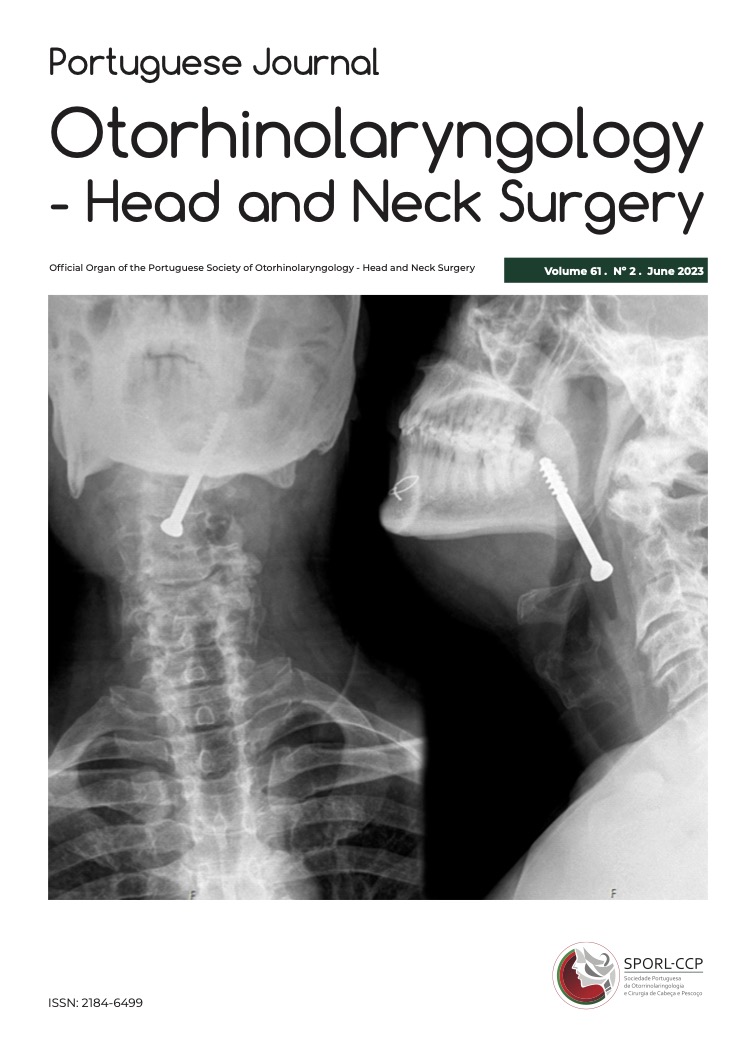Swallowing and ageing
DOI:
https://doi.org/10.34631/sporl.2027Keywords:
oropharyngeal dysphagia, aging, presbyphagiaAbstract
Swallowing disorders, including dysphagia, are highly prevalent in the elderly and are associated with significantly negative outcomes, including malnutrition, dehydration, pneumonia, reduced quality of life, and caregiver burden. Although oropharyngeal dysphagia is responsible for such complications, it is often not detected and treated. The elderly and caregivers often are unaware of their dysfunction.
Understanding the physiology of normal swallowing and swallowing disorders in the elderly is essential, as well as distinguishing between functional changes in swallowing in the elderly and dysphagia.
In addition to numerous screening tools and clinical evaluation protocols, videofluoroscopy and videoendoscopy of swallowing are considered the gold standard for the diagnosis of oropharyngeal dysphagia.
The primary goal of dysphagia intervention is to reduce the morbidity and mortality associated with respiratory infections and poor nutritional status, promoting safe and adequate nutrition and hydration with minimal complications.
Downloads
References
Maciel A, Maciel D. Swallowing of elderly without neurological disorders: case report. Rev CEFAC 2003; 5: 41-44
Butler SG, Stuart A, Leng X, Rees C, Williamson J, Kritchevsky SB. Factors influencing aspiration during swallowing in healthy older adults. Laryngoscope. 2010 Nov;120(11):2147-52. doi: 10.1002/lary.21116.
Doty RW, Bosma JF. An eletromyographic analysis of reflex deglutition. J Neurophysiol. 1956 Jan;19(1):44-60. doi: 10.1152/jn.1956.19.1.44.
Muhle P, Suntrup-Krueger S, Wirth R, Warnecke T, Dziewas R. Swallowing in the elderly : physiological changes, dysphagia, diagnostics and treatment. Z Gerontol Geriatr. 2019 May;52(3):279-289. doi: 10.1007/s00391-019-01540-4.
Panara K, Ramezanpour Ahangar E, Padalia D. Physiology, Swallowing. [Updated 2022 Jul 25]. In: StatPearls [Internet]. Treasure Island (FL): StatPearls Publishing; 2022 [cited 2023 Mar 06] Available from: https://www.ncbi.nlm.nih.gov/books/NBK541071/.
Madhavan A, LaGorio LA, Crary MA, Dahl WJ, Carnaby GD. Prevalence of and risk factors for dysphagia in the community dwelling elderly: a systematic review. J Nutr Health Aging. 2016;20(8):806-815. doi: 10.1007/s12603-016-0712-3.
Serra-Prat M, Hinojosa G, López D, Juan M, Fabré E, Voss DS. et al. Prevalence of oropharyngeal dysphagia and impaired safety and efficacy of swallow in independently living older persons. J Am Geriatr Soc. 2011 Jan;59(1):186-7. doi: 10.1111/j.1532-5415.2010.03227.x.
Rofes L, Arreola V, Almirall J, Cabré M, Campins L, García-Peris P. et al. Diagnosis and management of oropharyngeal dysphagia and its nutritional and respiratory complications in the elderly. Gastroenterol Res Pract. 2011;2011:818979. doi: 10.1155/2011/818979.
Sakai K, Nakayama E, Tohara H, Takahashi O, Ohnishi S, Tsuzuki H. et al. Diagnostic accuracy of lip force and tongue strength for sarcopenic dysphagia in older inpatients: a cross-sectional observational study. Clin Nutr. 2019 Feb;38(1):303-309. doi: 10.1016/j.clnu.2018.01.016.
Feng X, Todd T, Lintzenich CR, Ding J, Carr JJ, Ge Y, Browne JD. et al. Aging-related geniohyoid muscle atrophy is related to aspiration status in healthy older adults. J Gerontol A Biol Sci Med Sci. 2013 Jul;68(7):853-60. doi: 10.1093/gerona/gls225.
Butler SG, Stuart A, Leng X, Wilhelm E, Rees C, Williamson J et al. The relationship of aspiration status with tongue and handgrip strength in healthy older adults. J Gerontol A Biol Sci Med Sci. 2011 Apr;66(4):452-8. doi: 10.1093/gerona/glq234.J
Hara K, Tohara H, Kenichiro K, Yamaguchi K, Ariya C, Yoshimi K. et al. Association between tongue muscle strength and masticatory muscle strength. J Oral Rehabil. 2019 Feb;46(2):134-139. doi: 10.1111/joor.12737.
Mulheren RW, Azola AM, Kwiatkowski S, Karagiorgos E, Humbert I, Palmer JB. et al. Swallowing changes in community-dwelling older adults. Dysphagia. 2018 Dec;33(6):848-856. doi: 10.1007/s00455-018-9911-x.
Martin-Harris B, Brodsky MB, Michel Y, Castell DO, Schleicher M, Sandidge Jet al. MBS measurement tool for swallow impairment--MBSImp: establishing a standard. Dysphagia, vol. 23, no. 4, pp. 392–405, 2008, doi: 10.1007/S00455-008-9185-9.
Molfenter SM, Lenell C, Lazarus CL. Lazarus. Volumetric changes to the pharynx in healthy aging: Consequence for pharyngeal swallow mechanics and function. Dysphagia. 2019 Feb;34(1):129-137. doi: 10.1007/s00455-018-9924-5
Robbins J, Bridges AD, Taylor A Oral, pharyngeal and esophageal motor function in aging. GI Motility online. 2006 May. doi:10.1038/gimo39
Komiya K, Ishii H, Kadota J. Healthcare-associated pneumonia and aspiration pneumonia. Aging Dis. 2014 Feb 8;6(1):27-37. doi: 10.14336/AD.2014.0127.
Ney DM, Weiss JM, Kind AJ, Robbins J. Senescent swallowing: impact, strategies and interventions. Nutr Clin Pract. 2009 Jun-Jul;24(3):395-413. doi: 10.1177/0884533609332005.
McCullough GH, Martino R. Clinical evaluation of patients with dysphagia: importance of history taking and physical exam. In: Shaker R, Easterling C, Belafsky P, Postma G. editors Manual of diagnostic and therapeutic techniques for disorders of deglutition. New York: Springer; 2013. 412 p.
Rofes L, Arreola V, Romea M, Palomera E, Almirall J, Cabré M. et al. Pathophysiology of oropharyngeal dysphagia in the frail elderly. Neurogastroenterol Motil. 2010 Aug;22(8):851-8, e230. doi: 10.1111/j.1365-2982.2010.01521.x.
Rofes L, Arreola V, Almirall J, Cabré M, Campins L, García-Peris P. et al. Diagnosis and management of oropharyngeal dysphagia and its nutritional and respiratory complications in the elderly. Gastroenterol Res Pract. 2011;2011:818979. doi: 10.1155/2011/818979
Warnecke T, Suttrup I, Schröder JB, Osada N, Oelenberg S, Hamacher C. et al. Levodopa responsiveness of dysphagia in advanced parkinson’s disease and reliability testing of the FEES-Levodopa-test. Parkinsonism Relat Disord. 2016 Jul;28:100-6. doi: 10.1016/j.parkreldis.2016.04.034.
Schindler A, Baijens LWJ, Geneid A, Pizzorni N. Phoniatricians and otorhinolaryngologists approaching oropharyngeal dysphagia: an update on FEES. Eur Arch Otorhinolaryngol. 2022 Jun;279(6):2727-2742. doi: 10.1007/s00405-021-07161-1.
Mozzanica F, Lorusso R, Robotti C, Zambon T, Corti P. et al. Effect of age, sex, bolus volume, and bolus consistency on whiteout duration in healthy subjects during FEES. Dysphagia. 2019 Apr;34(2):192-200. doi: 10.1007/s00455-018-9961-0.
Peladeau-Pigeon M, Steele CM. Age-related variability in tongue pressure patterns for maximum isometric and saliva swallowing tasks. J Speech Lang Hear Res. 2017 Nov 9;60(11):3177-3184. doi: 10.1044/2017_JSLHR-S-16-0356
Downloads
Published
How to Cite
Issue
Section
License
Copyright (c) 2023 The authors retain copyright of this article.

This work is licensed under a Creative Commons Attribution-ShareAlike 4.0 International License.






